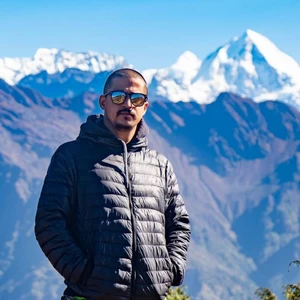Kala Patthar

Why save the best for last? Kala Patthar is the nearest and the best viewpoint in the whole Everest region. For other people than mountaineers, this is the closest you will get to the roof of the world on foot. Kala Patthar is a peak with a prominence of only 10 meters but is the highest point you will reach during the Everest base camp trek with an altitude of 5644 meters.
Kala Patthar translates to “black rock.” As the last milestone during the base camp trek, it is considered a very important landmark. The ascent to its summit starts from Gorakshep, an ancient lake bed, and an important and closest settlement to Everest. The ever-famous pictures of Everest are taken from this vantage point.
Also, check, Mount Everest Helicopter Tour from Kathmandu
Gokyo Ri

Gokyo Ri lies a lot farther than Kala Patthar but provides a unique view. The peak of Gokyo Ri is a prominent peak with an altitude of 5,347 meters situated between the lakes, Gokyo IV - Tonak Pokhari and Gokyo - Dudh Pokhari. From the top, you can see four 8000-ers, Mount Everest, Makalu, Lhotse, and Cho Oyu.
The region is home to Gokyo Lakes, an oligotrophic lake system with six main lakes, and the world’s highest freshwater lake system. Along with the view of the mighty snowy peaks, you will see the amazing sky-blue lakes adding to the beauty of the landscape.
Pikey Peak

A relatively new trekking route in the Everest region, Pikey Peak is probably the best viewpoint in all of the country. It has been dubbed the best vantage point of Mount Everest by Sir Edmund Hillary. Unlike the trail to Everest base camp, it falls in lower Khumbu of the Solukhumbu district.
Here, you will not only see Everest but seven other 8000-ers if you are lucky. In the east, these peaks are visible: Mount Everest, Kanchenjunga, Cho Oyu, Makalu, and Lhotse. In the west, you will see the following: Annapurna I, Manaslu, and Dhaulagiri.
Hotel Everest View

A popular detour destination during the Everest base camp trek on the acclimatization days at Namche Bazaar, Hotel Everest View is not just a hotel but a landmark. It is a hotel situated at the highest altitude in the world. It not only provides an amazing view of Everest, but you can also enjoy 360° views of snow-capped peaks.
A piece of luxury in the Himalayas, this hotel is a destination in itself. Established in 1971 by Takashi Miyahara, the hotel is a piece of paradise that seek luxurious accommodation and food in a remote area. You can reach there by trekking from Namche Bazaar or via a helicopter directly to the hotel. You will also stop at the Everest View Hotel during the helicopter tour to the Everest base camp.
Tengboche Village

Tengboche is a Himalayan village that lies at an altitude of 3,860 meters and falls on the trail to the Everest base camp. You will stay the night at this Sherpa village, home to the largest monastery in the region. Tenzing Norgay, one of the first people to scale Mount Everest, lived nearby and served as a monk in the monastery in his younger years.
This little village is an awesome vantage point from where you can see Everest, Lhotse, Nuptse, and Thamserku. Additionally, the view of Ama Dablam is spectacular from here.
Nagarjun Hill

Nagarjun Hill is a viewpoint that lies near the settlement of Dingboche. It lies at an altitude of 5100 meters and provides amazing views of the Himalayas. Nagarjun Hill is an acclimatization stop. On your acclimatization day in Dingboche during the trek to the Everest base camp, you will hike up to Nagarjun Hill early in the morning and enjoy the amazing views.
Chukhung Ri

Chukhung Ri is a rocky peak much like Kala Patthar. It lies north of the village of Chukhung and takes 3 to 4 hours to climb up to it. The peak provides an up-close view of the peaks of Lhotse, Nuptse, Ama Dablam, Thamserku, and more. This viewpoint, however, does not provide the views of Mount Everest.
The village of Chukhung lies on the way to Imja Tse, also known as Island Peak. The peak also serves as an acclimatization trip for people on their way to climb the Island Peak. Island Peak is a mountain with an altitude of 6160 meters, named so by the expeditioners of the 1953 Mount Everest summit.
Farak Ri, Kongde

Farak Ri is a 5000-meter peak situated near the village of Kongde. From here, you will see four of the highest peaks in the world, Everest, Makalu, Lhotse, and Cho Oyu, and the panoramic view of the Everest region.
You ascend to Farak Ri from Kongde village, a picturesque Himalayan village at an altitude of 4,250 meters, with views as good as any vantage point in the region. To reach Kongde, you pass through Thame, an old Sherpa village and the birthplace of Tenzing Norgay.
Renjo La Pass

Renjo La is one of the three high-altitude passes in the Everest region, a part of the three-pass trek. It is one of the passes to reach Gokyo lake. The pass not only has amazing views of Everest but also of the Gokyo lake system.
It is the westernmost of the three passes and also the easiest at an altitude of 5,360 meters.
Kongma La Pass

Kongma La is another pass in the three-pass trek in the Everest region at an altitude of 5,550 meters and provides amazing views of the Himalayas and the Gokyo lakes.
Nangkartshang Peak

Nangkartshang is a minor peak situated north of the village of Dingboche. The highest point of the peak is 5,615 meters. The peak can be used for acclimatization during the Everest base camp trek, instead of Nagarjun Hill. It is a moderately difficult hike and provides magnificent views of Makalu, Lhotse, Cho Oyu, and more.
.webp)











